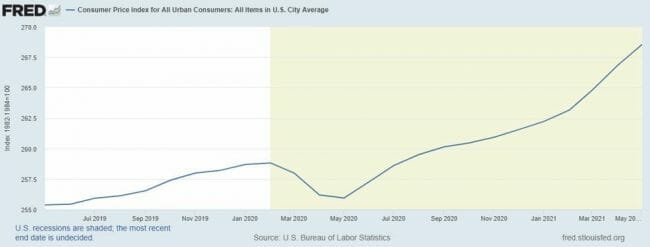What Runaway Home Prices Have To Do With Inflation (And How I’m Trading)
For the past couple of months, I have mentioned that I’m concerned about inflation. But in just the past two weeks, my concerns about inflation have intensified.
“Home prices in April saw an annual gain of 14.6% in April, up from a 13.3% increase in March, according to the S&P CoreLogic Case-Shiller National Home Price Index.
Price gains have been expanding for the last 11 months, as buyer demand continues to outstrip supply. The inventory of homes for sale rose slightly in May compared with April, but was still 21% lower than May 2020, according to the National Association of Realtors.”
The reason why this matters is simple. Housing accounts for about a third of the Consumer price Index. And I expect home prices to drive gains in the CPI for the next few months.

Source: Federal Reserve
Consumers agree with me that inflation is likely to rise, according to the Federal Reserve Bank of New York’s recent Survey of Consumer Expectations. The latest data shows that consumers expect inflation to be 4.0% in the next year and to average 3.6% in the next three years.
Older consumers and those with less education are most worried about inflation. Older consumers tend to spend more on housing, about 46% of income, according to the Bureau of Labor Statistics. Lower education is generally associated with lower income, and low-income households also tend to spend a higher proportion of income on housing.
How I’m Trading Right Now
My goal isn’t to cause alarm with my readers. My inflation concerns will only continue to grow if the evidence continues to point me in that direction. That also means I will vigilantly watch my portfolio over at Maximum Income.
If inflation does increase and it adversely affects some holdings, I will recommend closing those positions. In the current environment, it will be important to react to the incoming data and close positions that don’t act as expected.
I am not saying this because I am worried about any particular holding. I just don’t want our readers to be surprised if the data forces me to change my mind. In this way, I believe I am implementing the wisdom of John Maynard Keynes, who reportedly said, “When facts change, I change my mind.”
The main point, however, is that the overall strategy we use over at Maximum Income remains the same. That’s because our goal is to make trades that enhance our income from the stocks we own.
This is a strategy that works great in any market environment. But it can be especially handy right now because that extra income can help offset the effects of inflation.
Case in point, I recently recommended a trade in Philip Morris International Inc. (NYSE: PM), the international tobacco company.
This is a defensive stock. It offers a 4.9% dividend and should be attractive to value investors if there is a selloff in the stock market.
But with the strategy we use over at Maximum Income, we can collect even more income. And we can do it without taking on any unnecessary risk.
In fact, this strategy works like an “insurance policy”, protecting your capital in the event of a downturn – while still giving you the chance to enjoy some upside.
I think every investor owes it to themselves to at least learn how this works, which is why I’ve released a report that tells you everything you need to know.
